Full Text Searchable PDF User Manual
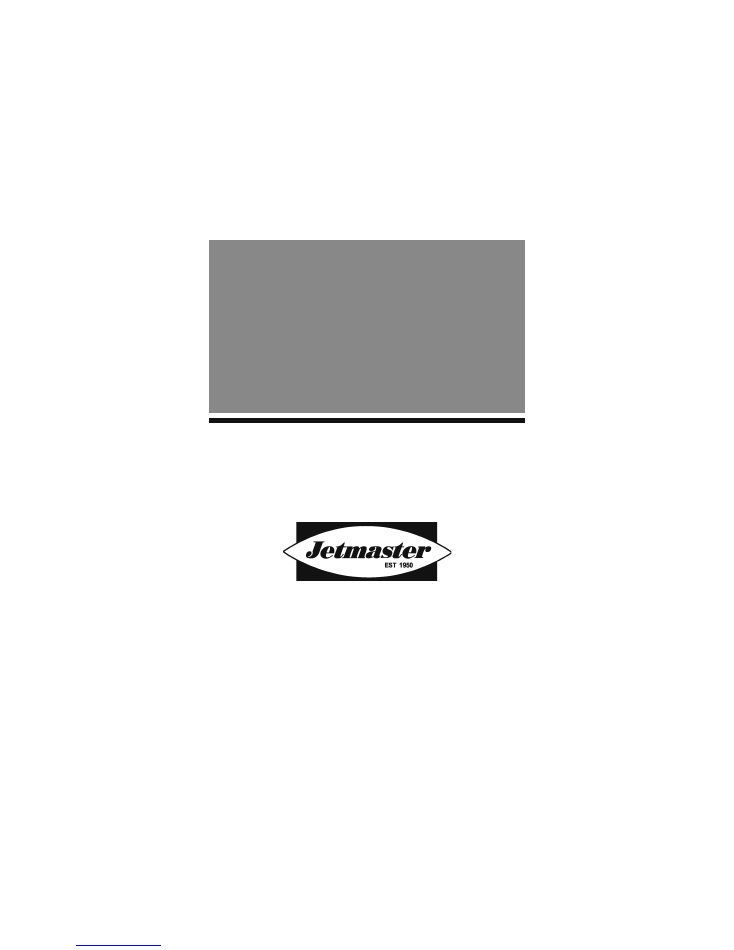
GENERAL
INSTALLATION
& OPERATION
INSTRUCTIONS
JETMASTER (VIC) PTY LTD
ACN 005 872 159 ABN13 659 821 337
444 Swan St. Richmond VIC 3121 PO Box 5051 Burnley 3121
Phone: (03) 9429 5573 Fax: (03) 9427 0031
Website: www.jetmaster.com.au Email: info@jetmastervic.com.au
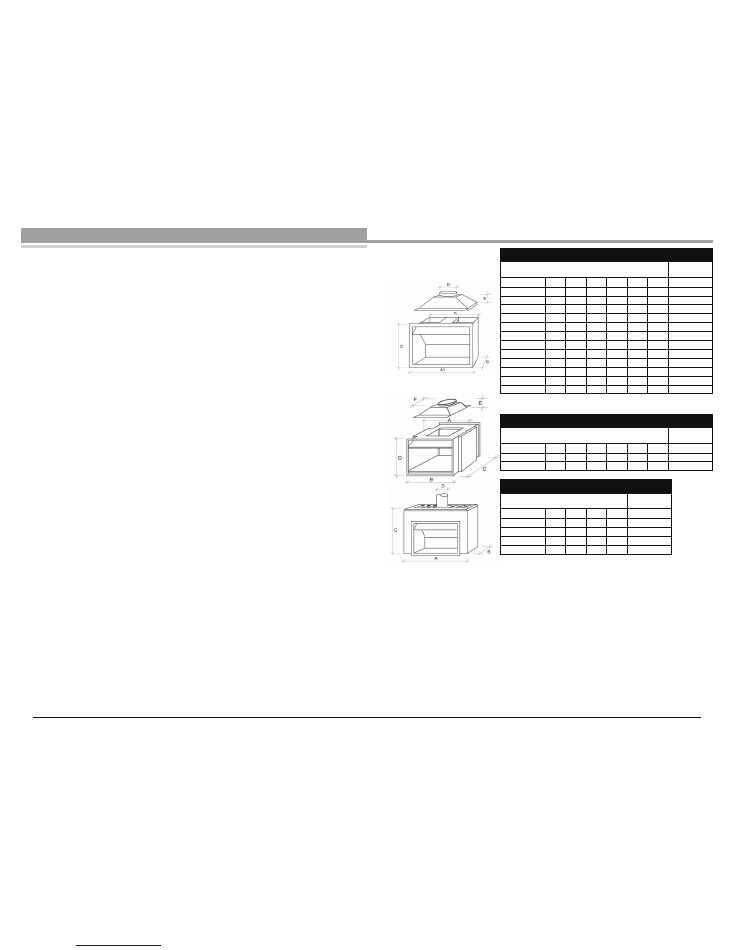
1
ASSEMBLY AND INSTRUCTION
• Position unit on finished hearth level - ensure air intake at base of unit is not
obstructed;
• Bolt gather to unit;
• Insulate entire unit and gather where painted red;
• Bolt Lintel (optional) to unit - insulate between unit and Lintel;
• Rivet inner flue to collar of gather at three places;
• Rivet all further inner flues at three places;
• If using double skin flues space inner and outer flues using 3 x 25mm self tapping
screws through outer casing at bottom, at each join and at top. Also ensure that
flues are ventilated at top and bottom, and when using a cover cone drill a series
of holes into the outer flue below the cover cone to ensure adequate ventilation;
• Fit cowl to flue or chimney breast.
RECOMMENDATIONS
• Do not recess unit by more than 110mm
• Use a minimum of 3.6 metres lengths of flue
JETMASTER UNIVERSAL - General Installation Instructions
JETMASTER UNIVERSAL
DIMENSIONS IN MILLIMETRES
Heating capacity
Cu. Meters
MODEL
A
A1
B*
C
D
E
Wood
440
470 510 330 610 200 200
75
500
570 600 350 650 200 200
85
600
670 700 350 650 200 200
100
600 LOW
670 700 350 600 200 200
100
700 SH
770 800 350 650 200 200
130
700 SH LOW 770 800 350 600 200 200
130
700D
770 800 400 700 225 200
160*
850
920 950 450 750 250 220
180
850 LOW
920 950 450 700 250 220
180
1050
1120 1150 500 800 300 240
220
1200
1250 1300 605 1020 250** 400
300
1500
1550 1600 605 1020 300** 400
350
*Tested to 15Kw at maximum burning.
** Requires 2 flue outlets (single flue option also available)
JETMASTER DOUBLE-SIDED
DIMENSIONS IN MILLIMETRES
Heating capacity
Cu. Meters
MODEL
A
B
C
D
E
F
Wood
700
800 800 610 700 220 345
200
1050
1205 1150 600 770 233 415
300
JETMASTER FREESTANDING
DIMENSIONS IN MILLIMETRES
Heating capacity
Cu. Meters
MODEL
A
B
C
D
Wood
600
1000 390 810 200
160
700 SH
1050 390 810 200
180
700D
1100 440 911 225
200
850
1200 490 983 250
240
CONTENTS
JETMASTER UNIVERSAL - General Installation Instructions ................................. 1
Summary of Minimum Jetmaster Installation Specs ..........................................2 - 3
Jetmaster Installation into an Existing Fireplace ..................................................... 4
OPEN WOOD JETMASTER - Minimum Flue Height ............................................... 5
Construction Specifications - Jetmaster Traditional Victorian ................................. 6
Construction Specifications - Jetmaster Brick Veneer Installation ......................... 7
Construction Specifications - Jetmaster Installation Using Hebel .......................... 8
Construction Specifications - Jetmaster Traditional Space Saver .......................... 9
Construction Specifications - Jetmaster Traditional Edwardian On Stud Wall ..... 10
Construction Specifications - Jetmaster Free Standing Metal Casing “A” ............ 11
Construction Specifications - Jetmaster Free Standing Metal Casing “B” ........... 12
Construction Specifications - Jetmaster Double Sided “A” ................................... 13
Open Gas Jetmaster .......................................................................................14 -15
OPEN GAS FIREPLACE - Minimum Flue Height ................................................... 16
Open Gas Jetmaster .......................................................................................17 - 18
Operating and Maintenance Instructions - For wood burning Jetmaster ......19 - 20
How to Fit Fascias.................................................................................................. 21
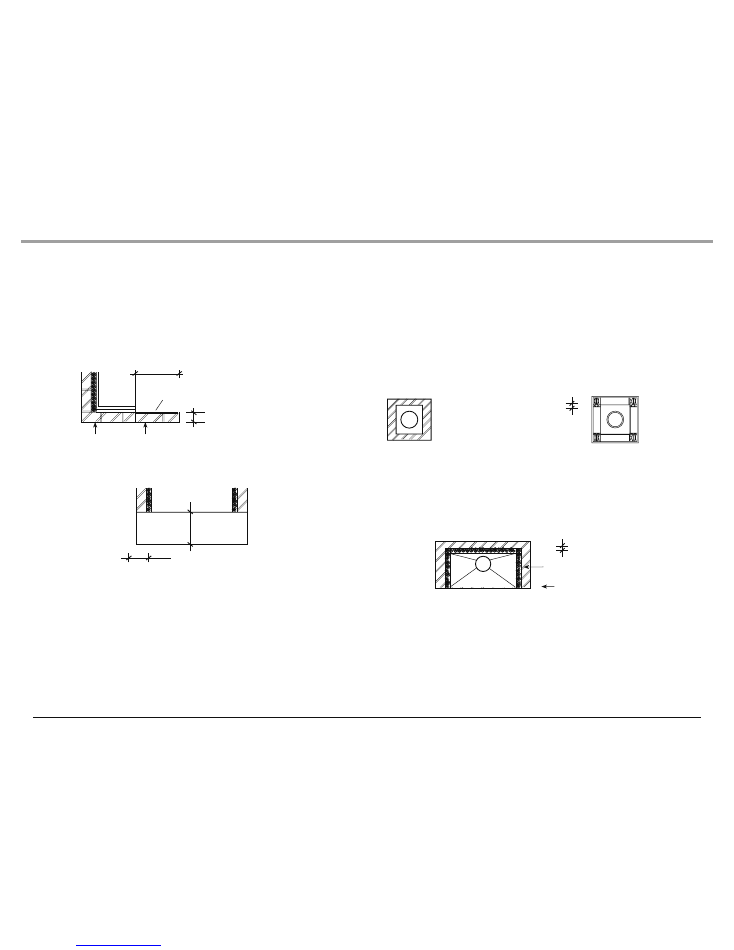
2
3
1. HEARTH
Must be constructed from a non combustible material such as concrete, brick, or autoclaved
aerated lightweight concrete block.
• Models 400-700D must be minimum 26mm thick.
• Models 850 - 1500 must be minimum 100mm thick. This includes selected finish
such as ceramic tiles, marble or granite.
• Must project forward of aperture by a minimum of 300mm.
• Must project either side of aperture by a minimum of 200mm.
25mm MIN.
INSULATION
BRICKWORK
JETMASTER
300mm MIN.
200mm MIN.
JETMASTER
SELECTED FINISH
BRICK ON EDGE
BRICK ON FLAT
300mm MIN
100mm MIN (Models 850-1500)
26mm MIN (Models 400-700D)
2. FLUE
• Single skin flue (stainless steel) must be enclosed with single skin brickwork,
concrete, or autoclaved aerated concrete block.
• Twin skin flues (stainless steel inner, and galvanised outer) can either be left
exposed or enclosed with stud walls and sheet plaster or timber.
A minimum of 50mm clearance must be maintained between the outer flue and
any combustibles. If using double skin flues space inner and outer flues using
3x25mm self tapping screws through outer casing at bottom, at each join and
at top. Also ensure that flues are ventilated at top and bottom, and when using
a cover cone drill a series of holes into the outer flue below the cover cone to
ensure adequate ventilation.
• Fit cowl to flue or chimney breast.
3. ENCLOSURE
• A minimum of single skin brickwork, concrete, or autoclaved aerated concrete
block must surround the firebox and gather at back, sides and front. A minimum
of 25mm air gap filled with insulation material provided must be maintained.
Summary of Minimum Jetmaster Installation Specs
Summary of Minimum Jetmaster Installation Specs
TWIN SKIN FLUE
STAINLESS INNER
GALVANISED OUTER
50mm MIN.
CLEARANCE
SINGLE SKIN
STAINLESS FLUE
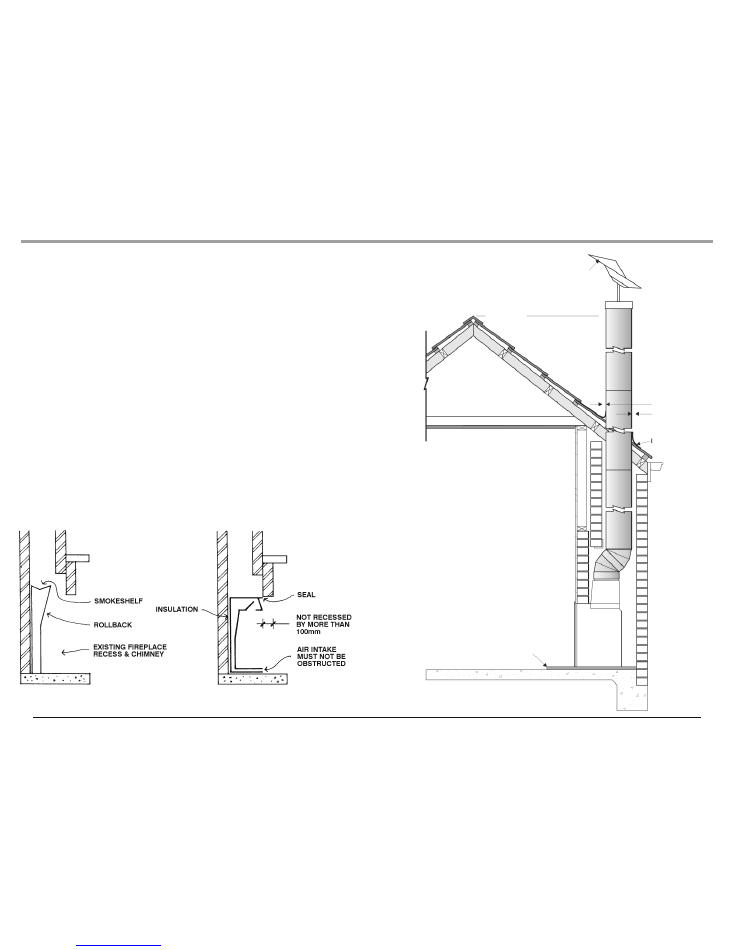
4
5
Jetmaster Installation into an Existing Fireplace
Step 1.
Measure the width, depth and height of your recess, too large or too small a
recess presents no problem at all.
a.
Too Large
– The recess can be reduced by inserting bricks at the sides,
and/or back, and, where necessary, between the top of the unit and the
underside of the lintel.
b.
Too Small
– The recess can be made deeper by removing the Rollback
and Smokeshelf. If the sides have to be removed this can be done,
however, it is suggested that an experienced builder carry out this work,
as the sides support the inner flues of the chimney. If the height is too low,
remove the lintel and replace it at the required height.
Step 2.
Check that your chimney is clean and free from obstructions. From the
measurements taken select the size of your Jetmaster.
Step 3.
Any cracks or cavities in the recess must be repaired and sealed.
Step 4.
Tape the insulation to the back and sides of the Jetmaster, and slide it into
place.
Note 1. Do not recess unit by more than 110mm.
Note 2. Do not have exhaust openings at top of unit obstructed.
Note 3. Do not have air intake at bottom of unit obstructed.
Step 5.
It is a good idea to light a fire at this stage, to check that all is well.
Step 6.
Seal the unit into position with either silicone, a metal flange, or masonry.
Allow masonry work to dry for minimum of three days before lighting the fire.
50mm
clearance
between roofing
materials &
any other
combustible
materials
Flashing
Rotating Cowl
Ridge Line
Hearth
Flue Termination
The minimum flue length is
3.5 metres or above the ridge
line (which ever is greater).
OPEN WOOD JETMASTER - Minimum Flue Height
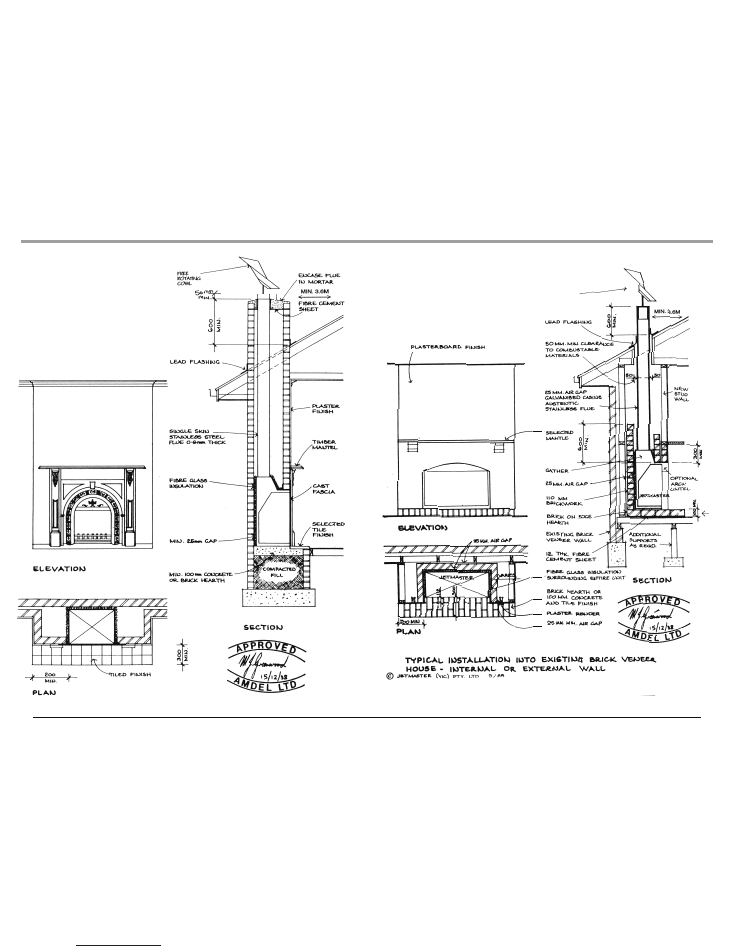
6
7
M
od
el
s
4
00
to
7
00
D
2
6m
m
Models 400 to 700D 26mm M
od
el
s
85
0
to
1
50
0
1
00
m
m
Models 850 to 1500 100mm
FREE ROTATING COWL
FREE ROTATING COWL
Construction Specifications - Jetmaster Traditional Victorian
Construction Specifications - Jetmaster Brick Veneer Installation
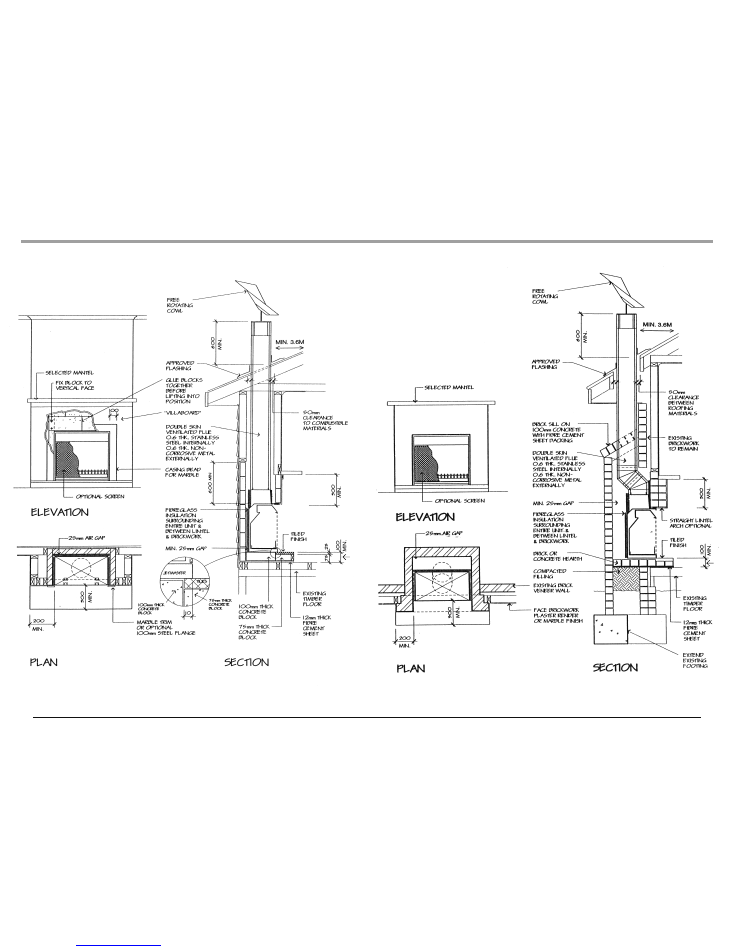
8
9
Construction Specifications - Jetmaster Installation Using Hebel
Construction Specifications - Jetmaster Traditional Space Saver
M
od
el
s
4
00
to
7
00
D
2
6m
m
Models 400 to 700D 26mm M
od
el
s
85
0
to
1
50
0
1
00
m
m
Models 850 to 1500 100mm
M
od
el
s
4
00
to
7
00
D
2
6m
m
Models 400 to 700D 26mm M
od
el
s
85
0
to
1
50
0
1
00
m
m
Models 850 to 1500 100mm
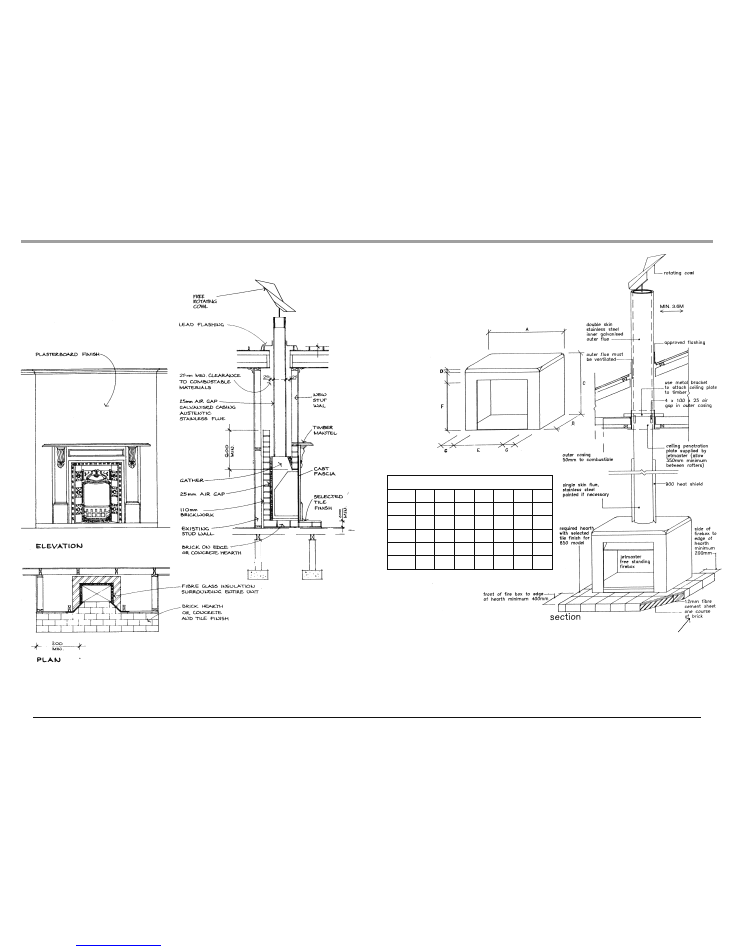
10
11
Construction Specifications - Jetmaster Traditional Edwardian On Stud Wall
Construction Specifications - Jetmaster Free Standing Metal Casing “A”
Typical installation with exposed “flue” and or one length
heat shield, refer to decro mesh diagram for firebox and
flue clearances to combustibles.
Hearth Thickness
Hearth Thickness
Models 400 to 850 26mm
Models 400 to 850 26mm
Model 1050 100mm
Model 1050 100mm
* Hearth extends 100mm behind firebox
* Hearth extends 100mm behind firebox
DIMENSIONS IN MILLIMETRES
MODEL
A
B
C
D
E
F
G
600
1000 390 810
40
600 600 200
700S
1050 390 810
40
700 600 175
700D
1100 440 119
40
700 650 200
850
1200 490 983
40
850 700 175
1050
1400 550 1050 40 1050 750 175
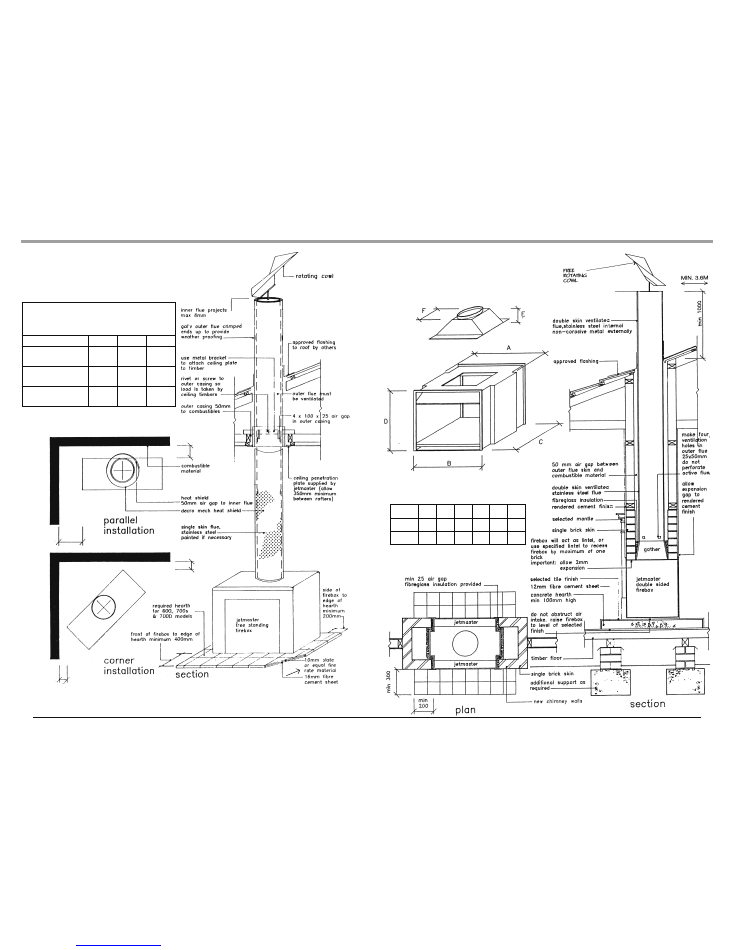
12
13
Construction Specifications - Jetmaster Free Standing Metal Casing “B”
Construction Specifications - Jetmaster Double Sided “A”
Hearth Thickness
Hearth Thickness
Models 400 to 850 26mm
Models 400 to 850 26mm
Model 1050 100mm
Model 1050 100mm
* Hearth extends 100mm behind firebox
* Hearth extends 100mm behind firebox
Typical installation with decro
mesh heat shield to ceiling.
FIREBOX AND FLUE CLEARANCES
TO COMBUSTABLES
Jetmaster 600, 700S,700D & 850 Freestanding
A
B
C
Flue Pipe
250
175
50
Flue Pipe with 900
Heat Shield
100
175
50
Flue Pipe with Decro
Mesh
100
175
50
NOTE: min. 400mm from front of firebox to edge of hearth
B
A
C
C
MODEL
A
B
C
D
E
F
700
850 800 610 700 270 345
1050
1090 1150 600 770 233 415
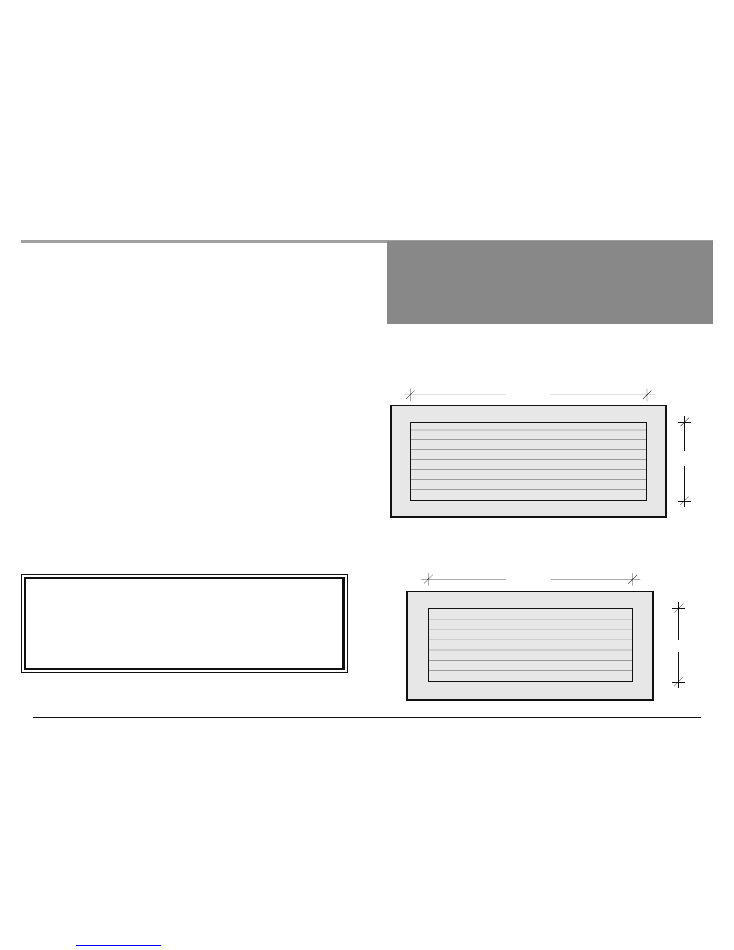
14
15
ROOMS WITH GAS OPEN FIRES
REQUIRE FRESH AIR VENTS
AS PER GAS REGULATIONS
For Example:
1 OFF: WOODFLOW VENT:
Or:
2 OFF VENTS REQUIRED:
430mm
125mm
125mm
270mm
Jetmaster Gas Open Fireplaces
• Refer to the relevant specification in “Wood Fires” section of this manual.
• An approved gas cowl must be fitted to the top of the flue or chimney.
• All open gas fires require fixed fresh vents in the room. See next page for
ventilation requirements.
•
Air movement systems
A decorative gas log fire must not be installed
where the operation of any ventilation system, fan or air blower could under
any circumstances cause the air pressure to be less than atmostpheric at the
appliance, or otherwise adversely affect the operation of the appliance.
• Do not block or restrict chimney or flue opening.
• After installing the appliance, check that the chimney/flue system draws well.
• Jetmaster recommends that all gas fires be serviced every 2 years.
• All gas units must be fitted by a licensed gas fitter.
• It is the responsibility of the gas fitter to follow the regulations set out in the Gas
Code that dictate the procedures to follow when installing a gas appliance,
particularly regarding gas pipe sizing and checking of pressures. (see summary
page)
• For installation of the gas burner, see instruction manual supplied with gas burner.
OPEN GAS JETMASTER
OPEN GAS JETMASTER
IMPORTANT - PLEASE NOTE
Failure of the gas fitter to install the appliance as per
manufacturer’s specifications and in line with the Gas
Code will invalidate the warranty.
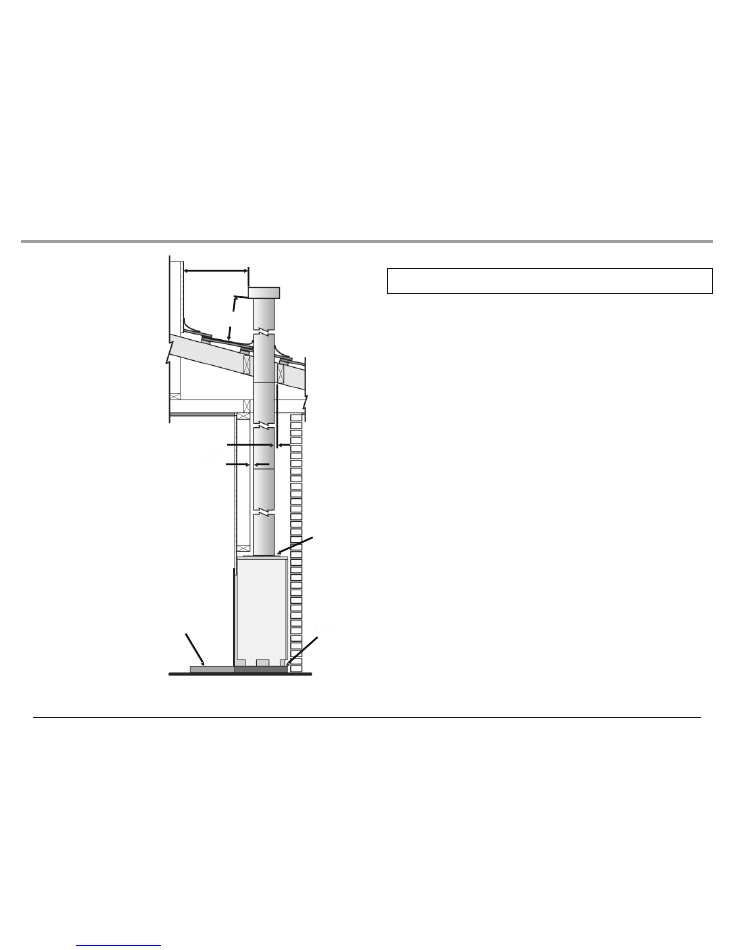
16
17
1 metre min.
Flue Cowl
AGA Approved
to AG604
500mm
min.
Flashing
25mm
minimum
clearance
Hearth
Packing
Flue Outlet
Flue Termination
The Flue Terminal shall be located
so that wind from any direction is not
likely to create a downdraught in the
flue. A Flue Cowl, AGA approved to
AS4566 (AG604) must be fitted to the
end of the flue pipe. The minimum
flue length must not be shorter than
3.5 metres. Maintain a minimum of
500mm from the bottom of the flue
cowl to the nearest part of the roof
if the flue cowl is at least 1m from a
neighbouring structure. If less than
1m, the flue terminal must be located
at least 500mm above that structure.
Refer to AS5601 - 2004 (AG601)
sections 5.13.6.2 and 5.13.6.4 to
ensure that the location of the flue
terminal fully complies for installations
with a trafficable roof, a chimney,
another flue terminal or near any
openings into a building.
OPEN GAS FIREPLACE - Minimum Flue Height
HOW TO SET GAS PRESSURES
PRESSURE ADJUSTMENT FOR CAMPFYRE LOG
GRL-24, GRL-700, GRL-830, GRL-850
It is critical that all gas products be properly installed. Proper installation must include:
1. Vent configuration in line with requirements stated in manual.
2. Vent cap/terminal meets all clearance stated in manual.
3. Gas pressure is checked and adjusted at the time of installation.
Note:
Pressures must be checked and adjusted to the correct specified
pressure otherwise warranty will be invalid.
The pressure is measured on the gas valve and the regulator can be adjusted by turning the
screws on the gas valve located either side of the pressure test points. (Refer to diagram
in installation manual).
If the gas pressure is not checked it can lead to “sooting”, “delayed ignition” or performance
issues. Proper gas outlet pressure ensures that the fireplace is operating within the
standards it was tested.
Ensure that the gas pressure does not change when other gas appliances in the home are
activated. If the “inlet” pressure into the gas fireplace was to change when other appliances
are activated this will cause the pilot flame to reduce in size, drop the millivolt output and
possibly cause the unit to shut down.
Reminder: The inlet pressure of the gas fireplace is an unregulated pressure. Only the
outlet pressure is held by the regulator located on the front of the gas valve.
Once installation is complete, it is imperative to do a smoke test to ensure that the gas
fumes are consistently drawn up the flue.
* This page does not take the place of the manual for each individual product, but is merely
stressing the above points. Always read and understand the manual prior to installing
any fireplace product.
Thank you for ensuring that our products are installed and operated safely.
Pressure “taps” are located at the face of the valve. There are two taps, one marked “
IN
”
and the other marked “
OUT
”.
- To check gas pressure simply turn the brass screw located in the “
OUT
” tap
counter clockwise several turns.
- Hook up a manometer tube to the “
OUT
” tap.
- Turn the fireplace on and turn the flame adjustment (if applicable) to high. The
outlet pressure should be set to the pressure stated on the
compliance plate on the floor of the unit.
- Turn the fireplace off.
- Remove manometer tube from “
OUT
” tap.
- Tighten the screw by turning clockwise until snug.
- Soap water test to check for gas leaks.
OPEN GAS JETMASTER

18
19
OPERATING AND MAINTENANCE INSTRUCTIONS
Your JETMASTER fireplace is designed not to smoke and by following a few instructions
you will achieve optimum heat output, convenience and fuel economy.
Please note that the first fire could result in a few odours coming from the firebox.
Do not be alarmed. This is not unusual when first using a metal finished product and
will soon cease.
LIGHTING A FIRE
1. Using a number of crumpled sheets of newspaper, some kindling and a few small
split logs arrange your fire in a “Teepee tent” style.
2. With the tool provided, fully open the DAMPER by pulling the control lever towards
you. (Not always applicable with Double Sided Firebox.)
3. Light the fire at both ends as well as at the centre.
4. When the kindling and small split logs are burning well, start to build up your fire
with larger
split logs.
5. When the fire is well established you can start closing the Damper. The amount
you can close it will depend on the type of wood used and the general weather
conditions. Experience will soon show you how far; however, the damper should
never be closed more than half way.
6. When the fire has gone out completely, you can close the Damper fully thus
preventing any loss of heat from the room up the chimney.
CLEANING
1. The Jetmaster Log Pan is designed to give greater heat and fuel efficiency. For the
duration of the cold season
the Log Pan should never be emptied.
The resulting
bed of ash and coals from previous fires will soon become a heatbank generating
more heat than the burning logs. This ashbed also insulates and greatly extends
the life of the Log Pan. This is why an ashbed must be maintained at all times.
When the level of the ashbed becomes too high, the top layer can be removed.
Depending on frequency of use and quality of wood, this skimming procedure
should not be required more than once or twice a Season!
2. To prevent chimney fires as well as enabling the chimney to draw properly, the
chimney/flue should be swept at least once a season, subject to the quality of
timber used in the fire.
PRESSURE ADJUSTMENT FOR
IRONBARK, STANDARD COAL, TOPAZ & DELUXE LOGS & COALS
Put manometer onto test nipple on regulator and adjust regulator to 1 kpa with burner on
high.
PRESSURE ADJUSTMENT FOR
SUPERCOAL
- Test point for outlet pressure is located on the on the left of the gas valve.
- Adjust to pressure stated on compliance plate.
- Check unit on low setting.
SUMMARY TAKEN FROM THE GAS INSTALLATIONS
AUSTRALIAN STANDARDS
AS5601-2002 AG601-2002
IMPORTANT: THIS IS A SUMMARY ONLY. THE GAS FITTER MUST REFER TO
THE GAS INSTALLATIONS AUSTRALIAN STANDARDS IN DETAIL.
Appendix F Sizing Consumer Piping
- New Consumer Piping Systems
When sizing a new consumer piping system, consideration should be given to
foreseeable future needs.
- Existing Consumer Piping Systems
When an additional appliance is to be connected to an existing consumer piping
system, the existing piping, metre and regulator should be checked to ensure that
adequate capacity is available for the additional load.
- Information Required Prior To Pipe Sizing
The following information is required prior to pipe sizing:
a. The type of gas, including the heating value and relative density.
b. The gas consumption of each appliance.
c. An allowance, if any, where there is a probability that not all appliances will be
used at the same time.
d. The pressure available at the start of the consumer piping.
e. The allowable pressure drop shall be such as to ensure that at least the
minimum inlet pressure required by the appliance is available at the appliance.
f. The proposed layout of the consumer piping system including all pipe lengths
and the location of each appliance.
NOTE:
See tables in this appendix
OPEN GAS JETMASTER
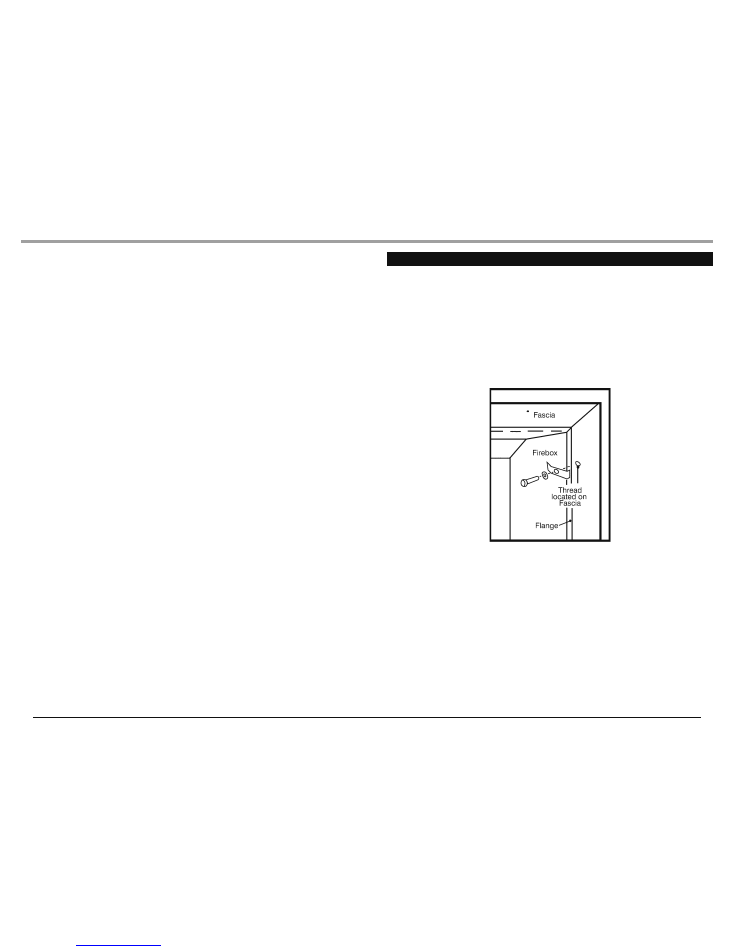
20
21
OPERATING AND MAINTENANCE INSTRUCTIONS
General Maintenance
The visible parts of your Jetmaster can be cleaned with a damp cloth or soft brush. Should
you wish you could repaint the unit with a heat resistant paint.
Safety
The Jetmaster is a safety-tested unit. However, you must never leave an open fire unguarded.
Jetmaster has a screen that is designed to prevent sparks leaving the fireplace and very
resistant to being accidentally knocked over by young children.
Fuels
1. Medium density woods are preferred for open fireplaces. Softer woods (Pines etc)
burn fast, leaving a lot of ash and creosote. Hard woods (Red Gum etc) can be
best used when mixed with medium woods and should not be used to start a fire.
2. A split log will burn better than a full log.
3. Wood should be stored (seasoned) in a dry ventilated area for at least 12 months.
“Green” wood can have 50% moisture, which results in a very poor heat emission.
Box woods (e.g. Grey Box and Yellow Box) are highly recommended as they
produce fine coals.
Burning well seasoned medium density wood is the most important step
towards achieving optimum results from your JETMASTER!
HOW TO FIT FASCIAS
1. Use lugs and bolts provided and attach to flange on firebox.
OR
2. Use masonry plugs and drill through corners of fascia and attach to bricks.
OR
3. If neither of the above is suitable, then use heat resistance bonding silicon.
Note:
Mantelpiece will hold fascia in position.
100mm Stainless Steel Trim Method for Attachment
1. Score the back of the stainless steel trim and the surface to which the trim will be
attached, to allow the two surfaces to adhere well to each other.
2. Place a bead of Silicone onto the back of the stainless steel trim.
3. Place another bead of Liquid Nails around the outer edge of the frame.
This will cure quickly and hold the frame into position.
4. Clamp the trim onto the unit for 24 hours until the adhesives have cured.
How to Fit Fascias

22